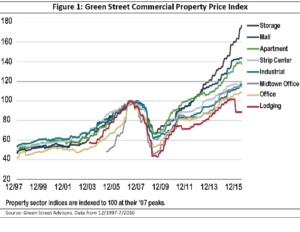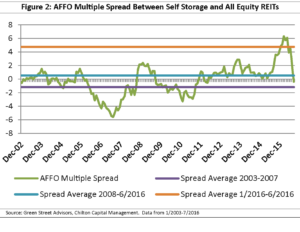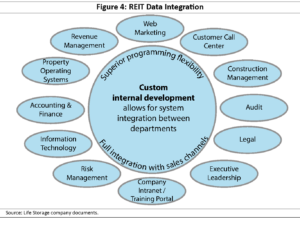Self Storage REITs: Up to the Challenge | September 2016
September 1, 2016
The self storage sector has been the top performing property type in 2 of the past 5 calendar years. In fact, the Bloomberg Self Storage REIT Index (Bloomberg: BBREPBST Index) has outperformed the MSCI US REIT Index (Bloomberg: RMS G) every calendar year since 2010, averaging 1,200 basis points (or bps; 1bp = 0.01%) better per year. While some of the outperformance may be due to the sector finally getting respect for some of its inherent attributes, cash flow growth was also superior to other REIT property types over the same period, thereby justifying the performance. However, the self storage sector is underperforming the RMS by 1,977 bps year to date as of August 29, 2016. While sector cash flow growth is decelerating, the sector is still projected to be the top same store net operating income (SSNOI) grower from 2016-2020, on average. The recent pullback is unjustified in our view and presents a buying opportunity in a sector that has appeared expensive for more than a year.

As we are now seven years into the current real estate cycle, all sectors have benefited from the US economic recovery coming out of the Great Recession. However, some have seen values rise more than others. According to the Green Street Advisors Commercial Property Price Index as shown in Figure 1, the value of REIT-owned self storage facilities has risen 77% from the 2007 peak to July 31, 2016, more than 3,400 bps higher than the closest sector (regional malls). In fact, self storage has had an unprecedented value increase this cycle: prior to 2007, self storage traded at an average discount to other sectors based on price / AFFO (Adjusted Funds From Operations) multiples. Self storage REITs traded at an average AFFO multiple of 17.9x from 2003-2007, while all REITs (including self storage) traded at an average AFFO multiple of 19.1x, implying a difference of 1.2x as shown in Figure 2. However, from January 2008 to June 2016, the self storage sector traded at an average 0.5x multiple premium to all REITs (including self storage), as well as averaging a whopping 4.7x average multiple premium from January to June 2016. So, what made this cycle different for self storage?

This cycle produced especially impressive returns for self storage due to the unprecedented cash flow growth and cap rate compression from a broader acceptance of the sector as an institutional investment. Self storage rent and occupancy growth were essentially supercharged due to the large companies’ ability to use the internet and call centers to squash competition. Not surprisingly, cap rate compression followed, but at a level that was unforeseen by many investors (and likely owners too!). The combination of these two produced record valuations for self storage.
Admittedly, we underestimated the growth in occupancy and rent that the sector posted for the past few years. Looking back to our October 2014 REIT outlook titled “The Self Storage Playbook”, we boasted 2015 and 2016 SSNOI growth forecasts of +4.9% and +3.9%, respectively. The actual 2015 average SSNOI growth for the self storage REITs was +9.3%, and the average guidance midpoint for 2016 is +8.7% (does not include Public Storage (NYSE: PSA), which does not give guidance). Previous occupancy records have been beaten in each of the past 3 years, and 2016 looks to set another record high.
In addition to initially underestimating the occupancy growth and resulting pricing power for landlords, cap rate compression was much more robust, even including what we would have expected as a direct result from the precipitous fall in interest rates. Again referring to the October 2014 REIT outlook, we said that there was a possibility that several portfolios could garner cap rates below 5%, which compared to Wall Street applied cap rates above 6%. While we vehemently disagreed with the cap rates applied to the REITs by Wall Street, even we didn’t see cap rates going into the low 4%’s as they traded at the peak in March 2016
Self Storage Versus Apartments
Comparing self storage to the apartment sector is one useful tool to determine how an incremental investor may be looking at sectors that share similar attributes. Both of them are heavily influenced by population growth, location, and relatively short lease terms. They also benefit from a lower homeownership rate, provide monthly cash flow, and have low maintenance capital expenditures compared to other sectors. According to data from Green Street Advisors, apartments traded at an implied cap rate (the cap rate implied by a company’s current stock price) 60 bps lower than self storage REITs from 1998-2007, with only 7 months where self storage was at a lower cap rate. From January 2008 to July 2016, apartments averaged an implied cap rate 10 bps higher than self storage REITs. In fact, self storage has traded at a lower implied cap rate every month since October 2011!
In our view, self storage should trade at a lower cap rate than apartments. Though new supply can be an issue, the REITs have a significant advantage over their competitors in self storage, something that cannot necessarily be said about the apartment sector which is littered with successful private developers and owners. As a result, we project the sector will grow SSNOI at 4.5% compounded for the next 5 years, versus only 3% for the apartment sector. Also, the capital expenditures are the lowest among all sectors that own and operate commercial real estate. Finally, there is a portfolio premium that should be applied in self storage due to the benefits of scale on operating margins and the fragmented ownership that exists nationwide.
A Long Term Consolidation Opportunity
Self storage REITs traded at an average premium to NAV (Net Asset Value) of 26.0% over the past five years through August 2016 according to Green Street Advisors. However, as of August 30, 2016, the sector premium has fallen to 0.5%, and two self storage REITs are even trading at a discount to NAV. We believe that, despite decelerating fundamentals, the self storage REITs should trade at premiums to NAV, albeit less than recent history, due to excellent external growth opportunities, operational advantages over smaller competitors, and a low cost of capital.
From 2011 to June 30, 2016, the storage REITs acquired over 1,250 properties for a total of $11.5 billion. Recently, Extra Space (NYSE: EXR) acquired SmartStop for $1.3 billion, and Sovran Self Storage (now known as Life Storage (NYSE: LSI)) acquired Life Storage also for $1.3 billion. It is rare for large portfolio opportunities like these to arise, and as a result, pricing is often highly competitive. The REITs must have a distinguished platform value in order for the numbers to make sense. In these instances, both companies expect to gain efficiencies from additional scale as well as enhance the operations of the newly purchased portfolios, which should result in an average increase of 75 basis points in yield within the first year (with additional improvement expected in the outer years). Though a number of other sizeable portfolio acquisition opportunities exist, most of the long-term external growth will come from “one-off” transactions.

The 2016 Self Storage Almanac estimates the US contains 51,000 self storage facilities, with 41,000 facilities naming storage as the primary business. The largest owner is Public Storage with 6% of the industry, while the top 10 operators control 15% of the market. However, as seen in Figure 3, the following 90 operators only add an additional 4% in market share. The highly-fragmented nature of the industry gives the self storage REITs an opportunity to grow through consolidation.
According to EXR, about 46% of the self storage market is of institutional quality and not owned by the REITs. We estimate this equates to about $200 billion in acquisition opportunities. If acquired by the REITs, this would expand the Enterprise Value of the storage REIT sector from about $70 billion today to $270 billion, an increase of over 185%!
The Best in the Business
Operational advantages have played an instrumental role in the consolidation of the storage industry by the REITs. Because 85% of the industry is owned by small operators of three or fewer facilities, the typical private owner without an internet presence or revenue management system is at a major disadvantage. According to data compiled by REIS, a real estate research firm, large self storage operators (REITs and large operating companies like U-Haul (NASDAQ: UHAL)) from 2013-2015 on average achieved occupancy rates 200 basis points higher and rent growth 50 bps higher than smaller peers.

Much of the difference in performance can be attributed to the quality of management that the REITs are able to provide. The REITs’ size and scale have made it affordable to invest in superior operational technology as the companies are able to disperse the costs across hundreds or even thousands of properties. In particular, each REIT has invested heavily to create customized platforms that allow data from all departments to be integrated seamlessly into a pricing system (Figure 4). To put it into perspective, Life Storage’s revenue management system has 56 different inputs!
Enterprising companies have tried to help smaller operators close the gap, but problems still arise. Small operators have individual applications available to them that address separate aspects of the business, but a seamless program that allows the data to be fully integrated (like the REITs’ systems) is almost non-existent. As it stands today, the REITs have an immense operational advantage and they are continuously reinvesting in their systems in order to remain the industry leaders far into the future.
The Next Marketing Frontier
The internet is the fastest growing source of traffic for self storage leasing, which makes a web presence crucial to gaining and maintaining market share. Smaller companies without the ability to create a website internally can use a “make-a-website” company at a lower cost, but these websites are not sufficient to meet the convenience needs of today’s renter. Some of the common features on self storage REIT websites are: location-based property search functions, property-specific details, up-to-date inventory and pricing, online chat, an online reservation system, and a mobile version or app.
Extra Space has found that 80% of customers use their phone to search for a self storage unit; more than the computer, tablet, call center, or any other medium. Additionally, customers respond differently to the presentation of mobile data, and in order to stay ahead of increasingly sophisticated competition, mobile websites need to be more than just “mobile-friendly”. As a result, EXR has made mobile improvement one of its biggest priorities for 2016.
Search engine optimization, also known as “paid search”, creates yet another advantage for the REITs over their competitors. Paid search is not as simple as paying top dollar to be the first listing on a google search. There is an art to it, and often the optimal choice is to pay just enough to be in the top handful of listings while targeting a certain demographic in order to fill a specific unit-type vacancy within a precise market. The search results can be so targeted that if two people were to google search “storage in (city)” at the same time in the same location, it is highly unlikely they would receive the same results. To accomplish this is no simple task, and EXR has a 100 person team that handles all their interactive marketing efforts. The costs and resources required to operate industry-leading websites and attract customers via search engine optimization highlight the disadvantage that smaller operators have when competing with REITs, and thus the consolidation opportunity in the years ahead for REITs.
Development at a Reasonable Pace
CBRE, a commercial real estate firm, expects 600 facilities to be delivered in 2016 with another 900 due in 2017, equating to 1.2% and 1.8% of existing supply, respectively. After factoring in the standard obsolescence rate of 1%, new supply should not have a significant negative impact on cash flow estimates. For comparison, the previous cycle averaged annual new supply of 5.2%!
Assessing supply from a top-down view can put the numbers in perspective, but it is important to remember that storage is a localized business. Location is often the determining factor for storage rentals, and as a result, most facilities draw at least 75% of their tenants from within a 3-mile radius. For the higher-quality REIT portfolios, management teams claim the average trade area is closer to two miles and can even be as low as half a mile in denser miles. EXR estimates that 46 new facilities are under construction within their portfolio’s trade markets with another 26 in the planning phase, which is only a sliver of the total new supply projections! The high-quality and well-located nature of REIT portfolios should help insulate them from the impact of new supply.
New supply isn’t all negative for the REITs, though. Development is also a part of the companies’ expansion plans. As of June 30, 2016, the self storage REITs had announced $1.5 billion in planned development projects (includes joint ventures and certificate of occupancy deals), which equates to 10% of the expected deliveries for 2016-2017 (assuming average investment of $10 million per facility). Yields on developments can reach 8-10% upon stabilization compared to average acquisition yields in the 5-6% range for individual facilities.
The self storage REITs are expected to produce the highest cash flow per share growth of all REIT sectors in 2016 and the second-most in 2017. Despite decelerating fundamentals, cash flow and NAV growth should remain above historical averages as a result of superior operations and consolidation opportunities. The self storage sector has proven resilient in various economic conditions due to the consistency of its demand drivers: death, divorce, downsizing, and dislocation (also known as “the 4 D’s”). We view the sector’s current valuation as one of the best buying opportunities the sector has seen in recent memory.
Parker Rhea, prhea@chiltonreit.com, (713) 243-3211
Matthew R. Werner, CFA, mwerner@chiltonreit.com, (713) 243-3234
Bruce G. Garrison, CFA, bgarrison@chiltonreit.com, (713) 243-3233
Blane T. Cheatham, bcheatham@chiltonreit.com, (713) 243-3266
RMS: 1904 (1.31.2017) vs. 1904 (12.31.2016) vs. 346 (3.6.2009) and 1330 (2.7.2007)
Previous editions of the Chilton Capital REIT Outlook are available at www.chiltonreit.com/reit-outlook.html.
An investment cannot be made directly in an index. The funds consist of securities which vary significantly from those in the benchmark indexes listed above and performance calculation methods may not be entirely comparable. Accordingly, comparing results shown to those of such indexes may be of limited use.
The information contained herein should be considered to be current only as of the date indicated, and we do not undertake any obligation to update the information contained herein in light of later circumstances or events. This publication may contain forward looking statements and projections that are based on the current beliefs and assumptions of Chilton Capital Management and on information currently available that we believe to be reasonable, however, such statements necessarily involve risks, uncertainties and assumptions, and prospective investors may not put undue reliance on any of these statements. This communication is provided for informational purposes only and does not constitute an offer or a solicitation to buy, hold, or sell an interest in any Chilton investment or any other security.
for more info on our strategy
go now →
for more info on our strategy
go now →
VIEW CHILTON'S LATEST
Media Features
go now →
Contact Us
READ THE LATEST
REIT Outlook
go now →
disclaimers
terms & conditions & FORM ADV
SITE CREDIT
Navigate
HOME
TEAM
REITS 101
Approach
OUTLOOKS
media
Contact
back to top
VISIT CHILTON CAPITAL MANAGEMENT
This property and any marketing on the property are provided by Chilton Capital Management, LLC and their affiliates (together, "Chilton"). Investment advisory services are provided by Chilton, an investment adviser registered with the SEC. Please be aware that registration with the SEC does not in any way constitute an endorsement by the SEC of an investment adviser’s skill or expertise. Further, registration does not imply or guarantee that a registered adviser has achieved a certain level of skill, competency, sophistication, expertise or training in providing advisory services to its advisory clients. Please consider your objectives before investing. A diversified portfolio does not ensure a profit or protect against a loss. Past performance does not guarantee future results. Investment outcomes, simulations, and projections are forward-looking statements and hypothetical in nature. Neither this website nor any of its contents shall constitute an offer, solicitation, or advice to buy or sell securities in any jurisdictions where Chilton is not registered. Any information provided prior to opening an advisory account is on the basis that it will not constitute investment advice and that we are not a fiduciary to any person by reason of providing such information. Any descriptions involving investment process, portfolio construction or characteristics, investment strategies, research methodology or analysis, statistical analysis, goals, risk management are preliminary, provided for illustration purposes only, and are not complete and will not apply in all situations. The content herein may be changed at any time in our discretion . Performance targets or objectives should not be relied upon as an indication of actual or projected future performance. Investment products and investments in securities are: NOT FDIC INSURED • NOT A DEPOSIT OR OTHER OBLIGATION OF,OR GUARANTEED BY A BANK • SUBJECT TO INVESTMENT RISKS, INCLUDING POSSIBLE LOSS OF THE PRINCIPAL AMOUNT INVESTED. Investing in securities involves risks, and there is always the potential of losing money when you invest in securities including possible loss of the principal amount invested. Before investing, consider your investment objectives and our fees and expenses. Our advisory services are designed to assist clients in achieving discrete financial goals. They are not intended to provide tax advice, nor financial planning with respect to every aspect of a client’s financial situation, and do not incorporate specific investments that clients hold elsewhere. Prospective and current clients should consult their own tax and legal advisers and financial planners. For more details, see links below to CRS (Part 3 of Form ADV) for natural person clients; Part 2A and 2B of Form ADV for all clients regarding important disclosures.